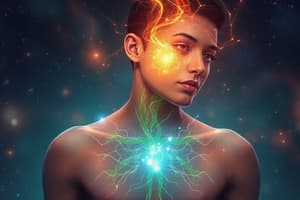Podcast
Questions and Answers
During which phase of puberty does the release of adrenal androgens primarily occur?
During which phase of puberty does the release of adrenal androgens primarily occur?
- Adrenarche (Phase 1) (correct)
- Gonadarche (Phase 2)
- Menarche
- Spermarche
How do secondary sex characteristics differ fundamentally from primary sex characteristics?
How do secondary sex characteristics differ fundamentally from primary sex characteristics?
- Secondary sex characteristics relate directly to reproductive capabilities, while primary sex characteristics do not.
- Primary sex characteristics develop later in puberty than secondary sex characteristics.
- Secondary sex characteristics directly involve reproductive organs, unlike primary sex characteristics.
- Primary sex characteristics relate directly to reproductive capabilities, while secondary sex characteristics do not. (correct)
Early developers, particularly girls, may experience specific challenges. Which of the following is a potential risk associated with early development in girls?
Early developers, particularly girls, may experience specific challenges. Which of the following is a potential risk associated with early development in girls?
- Lower risk of unwanted attention and teasing
- Decreased risk for substance abuse
- Increased risk for depression and eating disorders (correct)
- Increased likelihood of being more athletic and taller
If a teenager is described as a 'late bloomer,' what potential psychosocial challenge might boys specifically face?
If a teenager is described as a 'late bloomer,' what potential psychosocial challenge might boys specifically face?
What is the primary role of myelination in the adolescent brain?
What is the primary role of myelination in the adolescent brain?
Which part of the adolescent brain is targeted by pubertal hormones, influencing emotional responses?
Which part of the adolescent brain is targeted by pubertal hormones, influencing emotional responses?
How does Cognitive Behavioral Therapy (CBT) aid in the treatment of eating disorders during adolescence?
How does Cognitive Behavioral Therapy (CBT) aid in the treatment of eating disorders during adolescence?
Which of the following best describes how text messaging and email can influence sexual development in adolescents?
Which of the following best describes how text messaging and email can influence sexual development in adolescents?
According to Piaget's theory of cognitive development, what characterizes formal operational thought in adolescence?
According to Piaget's theory of cognitive development, what characterizes formal operational thought in adolescence?
What does Elkind's concept of the 'imaginary audience' refer to in the context of adolescent egocentrism?
What does Elkind's concept of the 'imaginary audience' refer to in the context of adolescent egocentrism?
How does relativistic thinking influence an adolescent's perspective on rules and principles?
How does relativistic thinking influence an adolescent's perspective on rules and principles?
Why is peer acceptance considered highly important during middle school?
Why is peer acceptance considered highly important during middle school?
According to Kohlberg's theory of moral development, what is a key characteristic of postconventional morality?
According to Kohlberg's theory of moral development, what is a key characteristic of postconventional morality?
In Marcia's identity statuses, what is characteristic of 'identity achievement'?
In Marcia's identity statuses, what is characteristic of 'identity achievement'?
How does gender identity differ from biological sex?
How does gender identity differ from biological sex?
How can peer pressure have a positive impact on adolescent development?
How can peer pressure have a positive impact on adolescent development?
According to Patterson's theory, what distinguishes 'early starters' from 'late starters' in the context of antisocial behavior?
According to Patterson's theory, what distinguishes 'early starters' from 'late starters' in the context of antisocial behavior?
What is the primary defining characteristic of 'parasuicide'?
What is the primary defining characteristic of 'parasuicide'?
During adolescence, what is the main reason that LGBTQ+ individuals struggle in social situations?
During adolescence, what is the main reason that LGBTQ+ individuals struggle in social situations?
Which of the following is not a treatment for eating disorders?
Which of the following is not a treatment for eating disorders?
Flashcards
Adrenarche
Adrenarche
The first phase of puberty, involving the release of adrenal androgens.
Gonadarche
Gonadarche
The second phase of puberty, marked by the release of sex hormones (estrogen, testosterone).
Menarche
Menarche
The first menstrual period in females, typically around age 12-13.
Spermarche
Spermarche
Signup and view all the flashcards
Primary Sex Characteristics
Primary Sex Characteristics
Signup and view all the flashcards
Secondary Sex Characteristics
Secondary Sex Characteristics
Signup and view all the flashcards
Growth Spurt
Growth Spurt
Signup and view all the flashcards
Prefrontal Cortex
Prefrontal Cortex
Signup and view all the flashcards
Limbic System
Limbic System
Signup and view all the flashcards
Myelination
Myelination
Signup and view all the flashcards
Synaptic Pruning
Synaptic Pruning
Signup and view all the flashcards
Muscle Dysmorphia
Muscle Dysmorphia
Signup and view all the flashcards
Bulimia Nervosa
Bulimia Nervosa
Signup and view all the flashcards
Anorexia Nervosa
Anorexia Nervosa
Signup and view all the flashcards
Binge-Eating Disorder
Binge-Eating Disorder
Signup and view all the flashcards
Metacognition
Metacognition
Signup and view all the flashcards
Imaginary Audience
Imaginary Audience
Signup and view all the flashcards
Personal Fable
Personal Fable
Signup and view all the flashcards
Postconventional Morality
Postconventional Morality
Signup and view all the flashcards
Marcia's Identity Statuses
Marcia's Identity Statuses
Signup and view all the flashcards
Study Notes
Physical Development and Puberty
- Adrenarche is the first phase of puberty
- Adrenarche involves the release of adrenal androgens
- Skeletal growth begins around age 6-8 during Adrenarche
- Gonadarche is the second phase, involving sex hormones like estrogen and testosterone
- Menarche is the first menstrual period, occurring around ages 12-13
- Spermarche is the first ejaculation, occurring around ages 13-14
- Primary sex characteristics relate directly to reproductive capabilities
- Secondary sex characteristics do not directly relate to reproductive capabilities
The Growth Spurt
- Growth spurts in girls occur around ages 8-13, and in boys around ages 10-16
- Growth spurts result in increased height and weight, reaching adult proportions
- Early-developing girls may receive unwanted attention and teasing
- Early developing girls may experience an increased risk for depression, eating disorders, early sexual activity, and substance abuse
- Early-developing boys may be more athletic and taller
- Early-developing boys may experience an increased risk for substance abuse and early sexual activity
- Late-developing boys may experience bullying, depression, and parental conflict
- Late-developing girls risk teasing and bullying
Brain Development During Adolescence
- The prefrontal cortex facilitates decision-making and higher-level cognition
- Myelination increases information processing speed
- Synaptic pruning strengthens the most important neural connections
- The limbic system develops before the prefrontal cortex
- The limbic system handles emotional processing, rewards, and punishments
- Pubertal hormones target the amygdala
- Dopamine, the "feel good" chemical, is produced more, and is involved in pleasure-seeking and risk-taking
- Serotonin balances dopamine, and extreme behaviors
- Melatonin levels increase later in the night, creating "night owls" rather than "early risers" in teens
- Teenagers require 9-10 hours of sleep
- A deficit of sleep increases impulsivity and negative emotions
Health Concerns During Adolescence
- Negative body image and body dissatisfaction is associated with poor nutrition and atypical eating patterns
- Muscle dysmorphia involves an obsession with muscle development
- Bulimia nervosa involves binge/purge cycles and often normal weight
- Anorexia nervosa involves a distorted body image, underweight, and low caloric intake
- Binge-eating disorder involves overeating sprees, often associated with anxiety, depression, and obesity
- Anorexia is the most fatal mental disorder, and suicide is more common with it
- Binge eating can result in Type II diabetes, obesity, high cholesterol, heart disease, and high blood pressure
- Eating disorders can be treated with Cognitive Behavioral Therapy (CBT), medication, counseling, and parental involvement/monitoring
Sexual Development
- Sexual interactions include body image ideals, media portrayals, masturbation, and sexual fascination
- Text messaging, email, and phone calls can evoke sexual feelings
- There is a risk of sexually transmitted infections (STIs) for sexually active teens
- Sex education is about more than just preventing teen pregnancy
- The genital stage of psychosexual development, involving the ego and superego, is part of Freud's theory
- Secondary-process thinking and desires develop during this stage
- Friendships, intimate relationships, and adult/family responsibilities become prominent during this time
Adolescent Cognition: Piaget and Elkind
- Piaget stated that constructivism is formal operational thought
- Formal operational thought is quantitative and a stage approach
- Hypothetical thinking asks "What if?" and uses deductive reasoning
- Abstract thinking recognizes that reality is not black and white
- Metacognition is thinking about thinking
- Elkind proposed adolescent egocentrism, based on Piaget's work
- Imaginary audience is the belief that others are watching and judging
- Personal fable is the belief in one's unique qualities
- Invincibility fable is the belief that probabilistic consequences do not apply to oneself
Adolescent Cognition: Information Processing, Risk-Taking, and Relativistic Thinking
- The dual-process model suggests that intuitive and analytical thought follow different pathways
- Intuitive thoughts are automatic, unconscious, fast, and experiential/emotional
- Analytical thoughts are deliberate, conscious, and rational
- Behavioral decision-making involves weighing rewards and consequences of actions
- Attitudes are attuned to social rewards vs. long-term consequences
- Relativistic thinking involves questioning absolute truth
- This includes religious doubt and rules based on one's own principles and common sense
- There is also cultural relativism
School in Adolescence
- Declining ages of puberty necessitates transitional education, and transition to early adolescence during middle school
- Changes in schedules, social dynamics, and egocentrism happen at this age
- Academic schedules, extracurricular involvement, and social expectations are factors
- Peer acceptance is very important
- Bullying including cyberbullying is an issue
- Bullying and cyberbullying involves technology and can causes psychological distance
- During high school, there is practice analytical thinking for adult life
- More time is spent with peers than with family
- Degree attainment predicts later success
- Academic achievement is an indicator of adjustment
Moral Reasoning
- Independence increases during adolescence
- Kohlberg's theory emphasizes postconventional morality, making morals based on self-chosen ethics and principles
- Influences on this are home, media, school, peers, and close friends
Psychosocial Development
- Identity is developing, rather than forming
- Self-concept is self-awareness based on beliefs, values, opinions, and thoughts
- Self-concept also involves possible and ideal selves
- There is no evidence of a severe adolescent drop in self-esteem
- "Barometric" self-esteem fluctuates which is based on self-concept and relationships
- Erikson's theory is Identity vs. Role Confusion, "Who am I?" & "Who do I want to be?"
- Identity can be achieved resolving a "crisis"
Identity Development
- Marcia’s Identity Statuses can vary in commitments
- Religious identity family influence questioning
- Political identity and social issues and youths tend liberal views than parents
- Vocational identities like Part-time teen jobs don't prepare you for full time careers
- Ethnic identity: like Phinney Stages such as Unexplored research and achievement
- Gender identity with self perception on a spectrum
Dimensions of Identity
- Gender identity is different from sex
- Sex is biological
- Gender is a social construct
- Cisgender identifies with gender assigned at birth
- Transgender are genders that differ from birth
- Genderqueer is gender that does not conform to construct
- Gender expression is largely based on expectation
- Masculine or Feminine or dimensions
- Sexual orientation sperate contracts like gender identity
- Emotional and sexual attraction
Understanding Social Development
- Social changes shifts from Parent to peers
- Less control or more autonomy
- Peer relationships is a flock of feather flock
- Peer pressure can be very positive
- Deviant Negative peer pressure
- Romantic Relationships are becoming more important and emotional
- LGBTQ have support coming more to families
Agression
- Early starts are very long term
- May be more personal factors
- Parental becomes less alternatives
- life- limited vs adolescence-limited,maturity comes earlier
- Typical life courses, maturity gaps
Anxiety and Depression
- Specific phobias are most commonly linked to anxiety
- Major depression is linked to genetic an early childhood
- Increase risk for gender differences
- Interactions with biological,cultural and suicide
- Distressing, suicidal or parasurcidal ideation
- Please talk about it
Studying That Suits You
Use AI to generate personalized quizzes and flashcards to suit your learning preferences.




